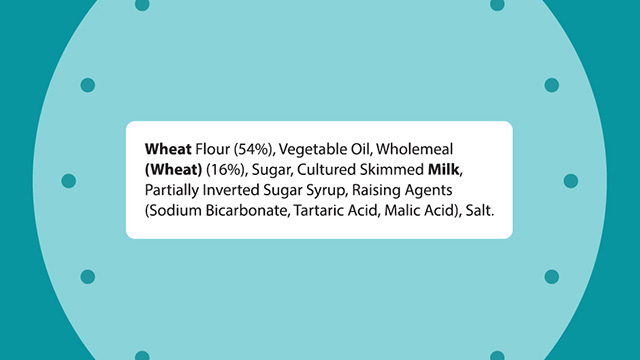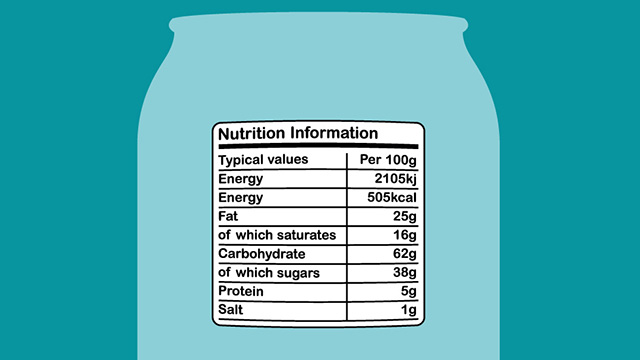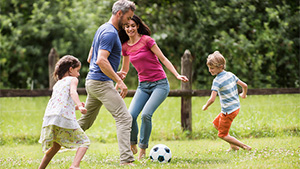FOOD LABELS AND FOOD PACKAGING
Today all manufacturers need to provide nutritional information on all pre-packaged foods and drinks found in the UK. You’ll find this information on the food label either on the front or back of pack, to help you understand the nutrient and calorie count.
When it comes to sugars in particular, below you’ll find lots of useful information about where you can find out just how much sugars are in a product by taking a closer look at the different food labels.
We often get asked as well about ‘added sugars’ or 'free sugars' and whether it's possible to figure out how much is in our food. The UK Government's dietary recommendations are based on free sugars which includes all added sugars in foods and drinks, and the sugars present in honey, syrups, fruit juices, smoothies, and fruit juice concentrates. However, only 'total sugars' is declared on food labels which include both the sugars naturally present in whole fruit and milk (instrincis sugars), and free sugars. For example looking at a plain yoghurt, it may state it contains 9.9g of total sugars. However, these are not 'free sugars' as they all came naturally from the milk.
At the moment, you won’t be able to find added sugars listed separately on a food label – this is because it’s not possible to accurately analyse the amount of added sugars in a food or drink product as you cannot distinguish naturally occurring sugar from added sugars in a laboratory given they are the same molecules. However, some countries are exploring how ‘added sugars’ could be calculated and shown on labels. For example, the US has started to introduce ‘added sugars’ on the labels of pre-packaged food and drink products, and the US Food & Drug Administration (FDA) is continuing to work with manufacturers to meet these new labelling requirements. ‘Added sugars’ are calculated based on product manufacturers’ proprietary recipes as a baseline.
To give you an example, when you make beer the sugars (glucose and maltose) from the malt are fermented to make alcohol which isn’t actually a sugar. What you may find as well, is that the sugars combine with other ingredients to enhance the flavour and/or colour of a product making it very difficult to determine where the sugars come from (i.e. have they been added? Do they occur naturally? Or have they been combined in the cooking process?).
INGREDIENTS LIST
 Knowing how much free sugars is in the food you buy is not always easy, but you should be able to find out whether a product contains sugars if you check the ingredients list. All the ingredients that have been used to make a product will be shown in order of weight. If you see 'sugar' listed then it is the same type of sugar that you find in your kitchen cupboard (sucrose), and if its first on the list then it's the biggest ingredient. There may also be other ingredients that contain free sugars such as fruit juice or purees, or other sugar ingredients e.g. glucose, fructose, maltose, syrup, honey.
Knowing how much free sugars is in the food you buy is not always easy, but you should be able to find out whether a product contains sugars if you check the ingredients list. All the ingredients that have been used to make a product will be shown in order of weight. If you see 'sugar' listed then it is the same type of sugar that you find in your kitchen cupboard (sucrose), and if its first on the list then it's the biggest ingredient. There may also be other ingredients that contain free sugars such as fruit juice or purees, or other sugar ingredients e.g. glucose, fructose, maltose, syrup, honey.
NUTRITIONAL INFORMATION

Another place you’ll be able to find out about sugars is on the nutritional information panel. This can be found typically on the back (or side) of pack and will list the major nutrients in a product in a particular order, including energy (both in kilojoules (kJ) and kilocalories (kcal), known as calories), and the amounts of fat, saturated fat (known as saturates), carbohydrates, sugars, protein and salt. Sugars will be listed as carbohydrates (which usually include both starches and sugars) and will use the phrase “of which sugars” to show how much sugars there are per 100g/100ml of product. Some products also show the nutrient content in grams per portion as a percentage of the Reference Intakes (formerly known as Guideline Daily Amounts).Fibre is also a carbohydrate and an important component of a healthy, balanced diet. However, it is not mandatory for fibre to be listed on the nutrition label, although many products do list it.
FRONT OF PACK LABELLING
You may also find information about sugars on the front-of-pack on a Reference Intake label, a traffic-light label or a combination of the two.

REFERENCE INTAKE AND TRAFFIC LIGHT LABELS
Reference Intake labels show you the energy (both in kJ and kcals - calories) per 100g or per 100ml, and the amounts of energy, fat, saturates, sugars and salt in a serving or a portion, along with the % Reference Intake (RI) of each nutrient and energy value, basd on an average woman's RIs.
A traffic-light label will contain the same information found in a Reference Intake label, but will have a traffic
light colour overlaid on top of the nutritional information to indicate at a glance whether the food or drink
contains a high (red), medium (amber) or low (green) amount of fat, saturates, sugars and salt. It is recommended to choose products with mainly greens and ambers, with less reds.
For further information, take a look at the British Nutrition Foundation's resource 'Looking at Nutrition Labels', a quick guide to understanding nutrition information on food labels to help people make healthy choces when shopping for food or the NHS 'How to read food labels' webpages.
SUGAR FACTS
- There is no such thing as 'hidden sugar'. It must always be declared on the food label.
- Government statistics show a reduction of around 18% per capita in consumption of total sugars in the UK since 2001 (51).



